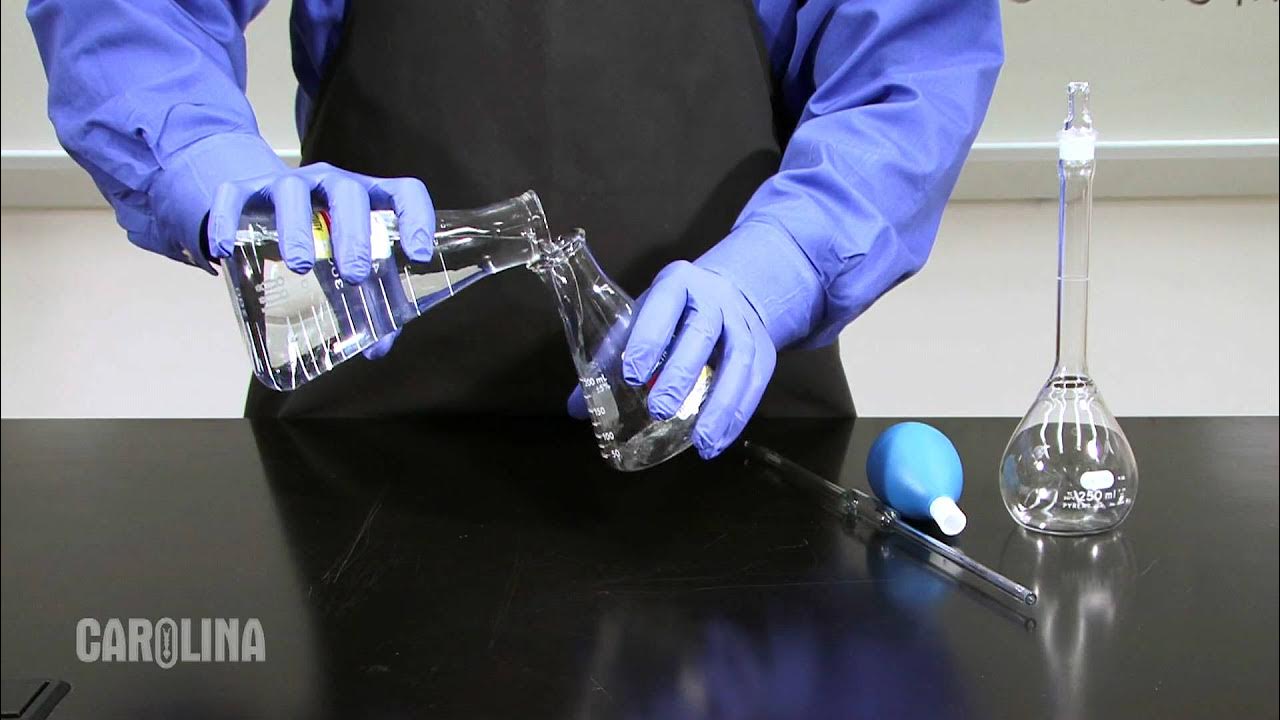Solution Preparation
Summary
TLDRIn this educational video, Assistant Professor Jared Heyman from Elon University explains the process of preparing a chemical solution with a specific concentration. He defines key terms like solute, solvent, mole, and molarity, and demonstrates how to prepare a 0.25 M sodium chloride solution. The video covers lab safety, measuring out sodium chloride, dissolving it in a volumetric flask, and calculating the solution's exact concentration, emphasizing the importance of accuracy in scientific measurements.
Takeaways
- 🔬 Preparing a chemical solution is a crucial skill in chemistry, involving the correct technique and procedure.
- ⚗️ A solution is a homogeneous mixture where a solute (smaller amount) is dissolved in a solvent (larger amount).
- 🧂 The demonstration uses sodium chloride (solute) dissolved in water (solvent) to prepare the solution.
- 📏 A mole is a counting term for the amount of a substance, similar to a dozen, but it's equal to 6.022 * 10^23 particles.
- ⚖️ The molar mass of sodium chloride is 58.43 grams per mole, made up of sodium and chlorine atoms.
- 🧪 Concentration is expressed in molarity (M), which represents moles of solute per liter of solution.
- 📐 The demonstration prepares 500 mL of a 0.25 molar sodium chloride solution, requiring precise measurements.
- ⚖️ The exact mass of sodium chloride required for this solution is 7.34 grams, measured using a balance.
- 🥼 Volumetric flasks are used for accurate volume measurements, while other labware like beakers are less precise.
- 💡 Final concentration of the prepared solution is determined by dividing the measured moles by the volume, resulting in 0.251 M sodium chloride.
Q & A
What is the main topic of the video?
-The main topic of the video is the technique and procedure for preparing a chemical solution, specifically a sodium chloride solution.
What is a solution according to the video?
-A solution is defined as a homogeneous mixture of two or more chemicals, where a smaller amount of one chemical, called the solute, is placed in a larger amount of a second chemical, known as the solvent.
Why is it important to observe lab safety procedures when preparing a chemical solution?
-Observing lab safety procedures is crucial because it helps to prevent accidents and ensure the safety of those working with potentially hazardous chemicals.
What is a mole in the context of chemistry?
-A mole is a counting term used in chemistry to define the amount of a substance, where one mole is equal to 6.022 x 10^23 entities, such as atoms or molecules.
How is the molar mass of sodium chloride calculated?
-The molar mass of sodium chloride is calculated by adding the molar mass of sodium (22.98 g/mol) and the molar mass of chlorine (35.45 g/mol), resulting in a total of 58.43 g/mol.
What is molarity and how is it expressed?
-Molarity, abbreviated as M, is the concentration of a solution expressed as the number of moles of solute dissolved in a liter of solution, with units of moles per liter (mol/L).
Why is it important to dissolve the solute completely before making up to the final volume?
-It is important to dissolve the solute completely before making up to the final volume to ensure that the concentration of the solution is accurate and that all solute is accounted for.
What is the purpose of a volumetric flask in solution preparation?
-A volumetric flask is used to prepare solutions with a precise volume, ensuring the accuracy of the solution's concentration by minimizing volume errors compared to other labware.
How is the meniscus formed when filling a volumetric flask and why is it important?
-The meniscus is formed due to the surface tension of water causing it to cling to the glass walls of the flask, creating a curved surface. It is important because the bottom of the meniscus should align with the calibration mark on the flask to ensure the correct volume.
What is the final concentration of the sodium chloride solution prepared in the video?
-The final concentration of the sodium chloride solution prepared in the video is 0.251 M (molar).
Why is it not appropriate to return excess reagent to the original container in a laboratory setting?
-It is not appropriate to return excess reagent to the original container to prevent contamination of the remaining reagent, which could affect the results of future experiments.
Outlines

このセクションは有料ユーザー限定です。 アクセスするには、アップグレードをお願いします。
今すぐアップグレードMindmap

このセクションは有料ユーザー限定です。 アクセスするには、アップグレードをお願いします。
今すぐアップグレードKeywords

このセクションは有料ユーザー限定です。 アクセスするには、アップグレードをお願いします。
今すぐアップグレードHighlights

このセクションは有料ユーザー限定です。 アクセスするには、アップグレードをお願いします。
今すぐアップグレードTranscripts

このセクションは有料ユーザー限定です。 アクセスするには、アップグレードをお願いします。
今すぐアップグレード5.0 / 5 (0 votes)






